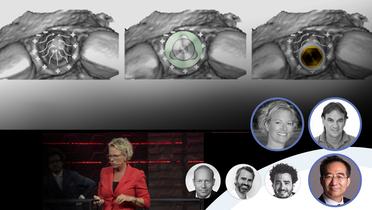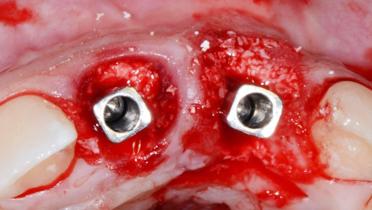-
0
Welcome and Introduction
00:00 - 01:45
-
1
Anterior single-tooth implants - case presentation and science review by Edith Groenendijk
01:46 - 32:55
-
2
Posterior single-tooth implants - case presentation and discussion by Ana Ferro
32:56 - 43:49
-
3
Posterior multiple units - bone grafting material review and case presentation by Tara Aghaloo
43:50 - 59:10
-
4
Posterior multiple units - case presentation by Ana Ferro
59:11 - 66:50
-
5
Options for the atrophic maxilla - review and case presentation by Tara Aghaloo
66:51 - 73:49
-
6
Audience questions and discussion
73:50 - 86:59
- 7 Community questions
FOR Symposium: To Graft or Not to Graft - that is the Question
Video highlights
- Grafting options for single-tooth indications
- Influence of post-extraction sockets
- Grafting to support treatment of multiple-unit indications
- Overview of bone grafting materials
- Options for edentulous indications
- Review of bone growth factors and their indications
During this symposium, Dr Ana Ferro (PT), Dr Edith Groenendijk (NL) and Dr Tara Aghaloo (US) discussed the question "To graft or not to graft". While some clinical situations may benefit from a grafting procedure, other situations may be successfully treated without a graft.
Single-tooth implant cases
The three experts start with a discussion on single-tooth implant cases, including trauma cases and cases that can be planned in collaboration with the patient. Dr Groenendijk starts to discuss single tooth implant cases in the anterior region. She addresses the challenges of post-extraction socket changes that raise the question of grafting procedures in the esthetic region. Dr Groenendijk shares two cases from her practice and accompanies the cases with recent clinical research to underline the treatment protocol she chose for each case [1-5]. She introduces the topic of immediate implant placement and the IIP (Immediate Implant Protocol) which can also be applied as the FIIPP (Flapless Immediate Implant Placement and Provisionalization Protocol). She presents her first case, an endodontically treated incisor that is causing pain and needs to be treated. The second case is a trauma case (bike accident) where Dr Groenendijk discusses a delayed protocol for restoration. In a discussion with Dr Ferro, Dr Groenendijk discussed when she raises a flap to access the site and when she prefers to apply the FIIPP.
Next, Dr Ferro shares an unusual case where she approached the treatment process from a different angle. She was faced with a failing tooth in the posterior maxilla and a need for a sinus lift in order to replace the molar in a successful way. She decided to start with the sinus lift and continued with the extraction and replacement of the molar. She explains her thought process and the flow of the treatment. She highlights the importance of including the patient in the treatment planning, to inform about different treatment options, and to prepare different treatment scenarios in order to be prepared for all circumstances that could happen during the surgery.
Multiple-unit implant cases
Dr Aghaloo joins the discussion by reviewing the biomaterials available on the market today for craniofacial defects, how they differentiate from each other, which indications they best serve and what to look out for when deciding to use biomaterials in a treatment protocol. Dr Aghaloo shares a case of a posterior multiple-unit restoration and explains how she handled the high expectations and demands coming from the patient. She also presents an overview of available growth factors and how they can benefit a treatment [6].
Dr Ferro continues by sharing a case of a restoration of a full quadrant (upper maxilla). In this case she used a pterygoid implant together with a regular implant to restore the situation. She explains her reasoning of this treatment choice in the discussion.
Edentulous cases
In the next part of the webinar, Dr Aghaloo discusses the options for atrophic situations in the maxilla. She reviews the solutions, optimal indications for each solution and the clinical data behind the treatment options [7-8] .
Questions and Discussion
As the last part of the webinar, the three experts discuss audience questions, as during the live event, participants were able to actively join the discussion by asking questions. View is as it took place live or start your own discussion by using the Q&A at the bottom of this page.
This video is available with captions in different languages - click on the cc button in the lower right corner of the video screen to select your preferred language.
References
[1] Tan WL, Wong TL, Wong MC, Lang NP. A systematic review of post-extractional alveolar hard and soft tissue dimensional changes in humans. Clin Oral Implants Res. 2012 Feb;23 Suppl 5:1-21. doi: 10.1111/j.1600-0501.2011.02375.x. PMID: 22211303.
[2] Wöhrle PS. Single-tooth replacement in the aesthetic zone with immediate provisionalization: fourteen consecutive case reports. Pract Periodontics Aesthet Dent. 1998 Nov-Dec;10(9):1107-14; quiz 1116. PMID: 10093556.
[3] Groenendijk E, Staas TA, Graauwmans FEJ, Bronkhorst E, Verhamme L, Maal T, Meijer GJ. Immediate implant placement: the fate of the buccal crest. A retrospective cone beam computed tomography study. Int J Oral Maxillofac Surg. 2017 Dec;46(12):1600-1606. doi: 10.1016/j.ijom.2017.06.026. Epub 2017 Jul 19. PMID: 28734634.
[4] Groenendijk E, Staas TA, Bronkhorst E, Raghoebar GM, Meijer GJ. Immediate implant placement and provisionalization: Aesthetic outcome 1 year after implant placement. A prospective clinical multicenter study. Clin Implant Dent Relat Res. 2020 Apr;22(2):193-200. doi: 10.1111/cid.12883. Epub 2020 Jan 28. PMID: 31991527.
[5] Groenendijk E, Bronkhorst EM, Meijer GJ. Does the pre-operative buccal soft tissue level at teeth or gingival phenotype dictate the aesthetic outcome after flapless immediate implant placement and provisionalization? Analysis of a prospective clinical case series. Int J Implant Dent. 2021 Aug 27;7(1):84. doi: 10.1186/s40729-021-00366-3. PMID: 34448101; PMCID: PMC8390706.
[6] Aghaloo TL, Le AD. Growth factors in implant site development. Oral Maxillofac Surg Clin North Am. 2004 Feb;16(1):111-25, vii. doi: 10.1016/j.coms.2003.12.002. PMID: 18088716.
[7] Ginebreda et al. AO abstract 2013
[8] El-Ghareeb M, Pi-Anfruns J, Khosousi M, Aghaloo T, Moy P. Nasal floor augmentation for the reconstruction of the atrophic maxilla: a case series. J Oral Maxillofac Surg. 2012 Mar;70(3):e235-41. doi: 10.1016/j.joms.2011.09.032. Epub 2011 Dec 16. PMID: 22177805; PMCID: PMC4045105.










